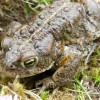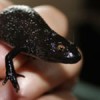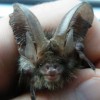
On the Solway coast we are lucky to have a number of very rare species, many of which are restricted to the coastal dunes and grassland which line the Solway Firth. Amongst the rarest species which reside on the Solway coast is the natterjack toad (Epidalea calamita). Natterjack toads occur on only a handful of sites in the UK and are one of the most threatened amphibian species in the country. Numbers of natterjack toads are declining across the species’ UK range and a number of historic populations have dwindled over recent years with some populations being lost entirely from specific sites. Once, natterjack toads could be found in suitable habitat from St. Bees Head to Southerness Point (on the Scottish side of the Solway). Today, the species is not known to occur anywhere south of Allonby on the Solway coast and populations elsewhere are fragmented. Research conducted in 2012 (by Pete Minting, working for the Amphibian and Reptile Conservation Trust) suggests that numbers of natterjack toads on the Scottish side of the Solway have declined to around 250 individuals – making them rarer than the Scottish wild cat in Scotland! Numbers on the English side of the Solway appear to be healthier, but are also known to be declining.
Natterjack toads are smaller than common toads, reaching around 8cm when fully grown. They are usually green or brown with a mottled darker pattern and a distinct yellow stripe running down the length of the back. They can live for up to 15 years and breed in ephemeral pools, usually in sand dunes, where the water is warm and the pools dry up annually. This means that predators such as fish and dragonfly larvae cannot become established but also means that they have a limited window in which the spawn must be laid, the eggs hatch and the young disperse before the pond dries up. Successful breeding is therefore dependant on suitable weather conditions during the breeding season. Because natterjack toads often occur in very low densities, the males need to attract females by calling from the edge of their chosen pond. The call is loud and on a still night can carry for more than 1km.
Potential and actual breeding ponds exist along the Solway coast. Breeding usually starts in April, when adults make their way to ponds and start to spawn. At this time of year particularly, it is important that ponds are not disturbed. A single dog going for a quick dip in a pond can severely impact upon their breeding sites; breaking up spawn strings, flattening emergent vegetation and muddying the water. We are very lucky to still have this species on our piece of the Solway and we should do everything we can to ensure they can continue to survive.
Records of natterjack toads are always valuable and if you see one please do report it. Records can now be submitted online at http://www.arguk.org/recording where you will also find an identification guide. Alternatively, feel free to contact me via the email address below.
Sam Griffin – Chairman of Cumbria Amphibian and Reptile Group (CARG)
Email; info@heskethecology.co.uk
First Published in ‘The Solway Buzz’ April 2013 (http://www.solwaybuzz.co.uk/Issues/issue_113/page_all.pdf)




